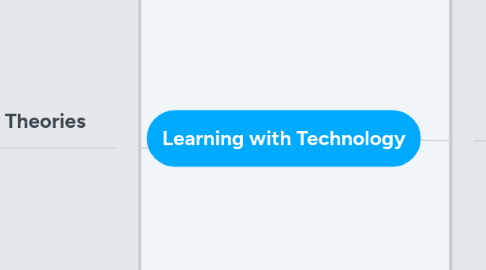
1. Learning Research and Theories
1.1. SOLE
1.1.1. Researched by Sugra Mitra
1.1.2. Freedom to inquire and present findings
1.1.3. Big question
1.1.4. Freedom to inquire and present findings
1.1.5. Three to four children in a group
1.2. Epistemic Beliefs
1.2.1. Dualistic
1.2.1.1. 'Right or wrong' knowledge handed down by authority
1.2.1.2. Supplementary
1.2.1.3. Teacher centred
1.2.1.4. Instructionall
1.2.2. Multiplistic
1.2.2.1. Multiple views but still believe that most knowledge is certain
1.2.2.2. Enrich
1.2.2.3. Mixed teacher/student centred
1.2.2.4. Relevatory
1.2.3. Relativistic
1.2.3.1. Most knowledge is tentative and contextual and generated by the self
1.2.3.2. Enrich
1.2.3.3. Mix teacher/student centred
1.2.3.4. Relevatory
1.2.4. Relativism
1.2.4.1. Knowledge is uncertain and based on the weight of accumulated evidence
1.2.4.2. Transform
1.2.4.3. Student Centred
1.2.4.4. Conjectural
1.3. GONSKI Report
1.3.1. General Capabilities
1.3.1.1. Literacy
1.3.1.2. Numeracy
1.3.1.3. ICT Capability
1.3.1.3.1. Creating with ICT
1.3.1.3.2. Communicating with ICT
1.3.1.3.3. Investigating with ICT
1.3.1.4. Critical and Creative Thinking
1.3.1.5. Personal and Social Capability
1.3.1.6. Ethical Behaviour
1.3.1.7. Intercultural Understanding
1.3.2. Equip every child to be a creative, connected and engages learner in a rapidly changing world
1.4. IMPACT
1.4.1. Inspire
1.4.1.1. Grab the students attention, generative intrigue through curiosity or connection to prior knowledge. Students predict future learning
1.4.2. Model
1.4.2.1. Visual information, chunking information into smaller goals, demonstrate use of knowledge to students
1.4.3. Practise
1.4.3.1. Repeat and commit knowledge to memory. Scaffold student tasks to ensure they practise the correct content
1.4.4. Apply
1.4.4.1. Use knowledge to answer questions about, using problem solving and higher order thinking skills
1.4.5. Connect
1.4.5.1. Connect with peers, globally or locally, collaboratively reflect on learning
1.4.6. Transform
1.4.6.1. Use knowledge creatively through decision making, problem solving and design.
1.5. Self regulated learning
1.5.1. Peer Learning
1.5.2. Metacognition
1.5.3. Effort regulation
1.5.4. Time management
1.5.5. GRIT
1.5.5.1. GRIT, characterised by resilience and self motivation is the biggest predictor of learning success
2. Technology
2.1. Technology Assisted Learning
2.1.1. Access
2.1.1.1. Technology to enable students to engage with the curriculum
2.1.1.2. Alternative keyboards, non-traditional mouse
2.1.2. Supportive
2.1.2.1. Technology to improve efficiency of learning
2.1.2.2. Seeing AI, immersive reader
2.1.3. Framework
2.1.3.1. Applications to cater to learning needs
2.1.3.2. Provide a blank slate, but a series of tools that allow the student to create
2.1.4. Curriculum
2.1.4.1. Applications to enhance learning in a specific curriculum focus
2.1.4.2. Software that focuses on a particular area of the curriculum (reading eggs)
2.2. Social Media
2.2.1. For teachers
2.2.1.1. Social Reasoning
2.2.1.1.1. Self
2.2.1.1.2. Others
2.2.1.2. Interactivity Reasoning
2.2.1.2.1. Take
2.2.1.2.2. Contribute
2.2.2. For students
2.2.2.1. Collaboration
2.2.2.2. Discussion
2.2.2.3. Research
2.3. TPACK
2.3.1. Technology Tools
2.3.1.1. Games as an Education Tool
2.3.1.1.1. Minecraft
2.3.1.1.2. The Old Man
2.3.1.2. Content Specific Tools
2.3.1.2.1. Scootle
2.3.1.2.2. Mathletics
2.3.1.3. Content Free Tools
2.3.1.3.1. GIF Generator
2.3.1.3.2. Explain Everything
2.3.1.3.3. EDraw
2.3.1.3.4. Meme Generator
2.3.1.4. Flexible Tools
2.3.1.4.1. Padlet
2.3.1.4.2. PPT
2.3.1.4.3. Kahoot
2.3.2. Pedagogical Style
2.3.2.1. Behaviourist
2.3.2.1.1. Students learn from the content.
2.3.2.1.2. Content Specific Technology
2.3.2.1.3. Dualistic/Multiplistic Epistemic Belief
2.3.2.2. Constructivist
2.3.2.2.1. Content Free Technology
2.3.2.2.2. Students generate knowledge or are guided towards a path to researching it.
2.3.2.2.3. Relativistic/Relativism Epistemic Belief
2.3.3. Example TPACK Analysis
2.3.3.1. European Settlers
2.3.3.1.1. Content: Investigate using google maps to identify schools, churches, landmarks, and create a community in minecraft
2.3.3.1.2. Technology: Minecraft, Google Maps
2.3.3.1.3. Pedagogy: Student centred, transformative pedagogical belief. Relativism epistemology. Conjectual learning.

